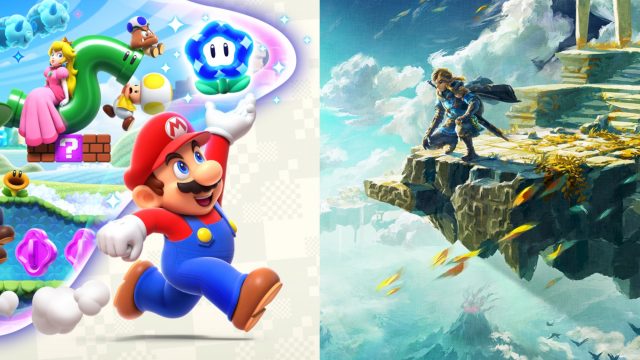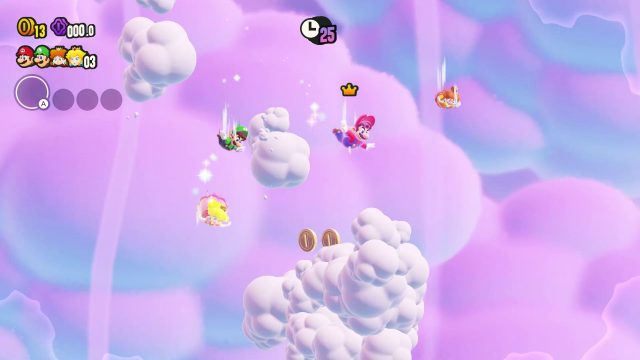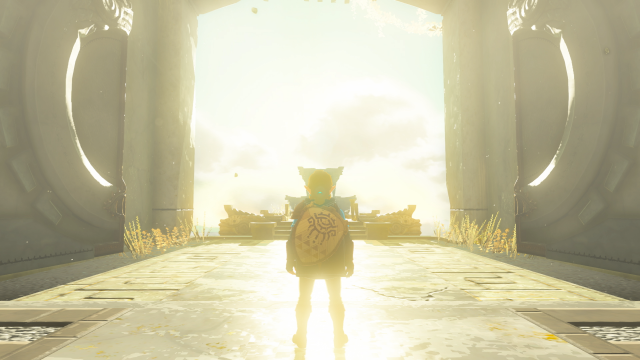The first official day of GDC 2024 kicked off with what were almost certainly two of the most popular sessions at the show (if not the most popular). As was the case at last year’s show, where Nintendo’s session on Kirby and the Forgotten Land was filled to capacity and had people listening in outside the room, this year’s talks were much the same. With lines wrapping around the convention halls hundreds of people deep, conference goers came out in a strong showing to hear insights on the development of Super Mario Bros. Wonder and The Legend of Zelda: Tears of the Kingdom.
Yours truly and our own editor-in-chief barely made it into the Zelda session, Tunes of the Kingdom: Evolving Physics and Sounds for The Legend of Zelda: Tears of the Kingdom, but it was well worth the effort trying to get in. Takuhiro Dohta (Technical Director, Tears of the Kingdom and Breath of the Wild), Takahiro Takayama (Lead Physics Engineer, Tears of the Kingdom and Breath of the Wild), and Junya Osada (Sound Programming Lead, Tears of the Kingdom and Breath of the Wild) joined forces to explore the intersection of environmental and sound design in the world of the last two entries in the Zelda series.
It was fascinating hearing how the team initially struggled with the world of Tears destroying itself during development due to non-physics-driven elements in the environment clashing with the physics-driven ones. After deciding that every element in the game must be physics-driven and follow the same set of physics rules, things started to fall into place — rather than out of place, and into the sky, and everywhere they absolutely shouldn’t have been.
While the development team’s ultimate goal with Breath of the Wild was to create a “vast and seamless Hyrule,” according to Dohta, the goal with Tears of the Kingdom was to expand on that vastness and seamlessness. He cited how some Zelda titles have incorporated dark worlds, and that the creation of the Depths was directly influenced by that. Additionally, the team sought to enhance what they call multiplicative gameplay: a game structure that lets players combine actions and objects to create many different ways to play. This was actually one of the topics of Nintendo’s 2017 GDC session while discussing development of Breath of the Wild.
The creation of Ultrahand was essential in driving the enhancement of multiplicative gameplay. The ability to craft vehicles and all sorts of structures, and to attach a variety of objects onto your weapons to create totally unconventional items, ensured no two playthroughs would be the same. Players can approach tasks in myriad ways, and they have the freedom to experiment with different solutions to problems in ways that differ from the abilities offered by the Shiekah Slate in Breath of the Wild.
And while the team worked hard to make sure the physics of Hyrule supported Ultrahand, they also put a ton of consideration into the game’s sound design. Osada took the stage to discuss the ins and outs of how the game’s physics directly impacted its sound effects. Interestingly, many of the sounds that players might think were pre-recorded actually weren’t. For example, the sound engineers didn’t record the sound of a wagon rolling to get those sounds for the game; instead, the in-game sound is the result of the sounds of all of the individual parts of the wagon (wheels, chains, etc.) moving as one unit.
Ultimately, the Zelda team wanted to create a system where fun things happen, rather than creating fun. Given the success of Tears of the Kingdom and the hours players have spent creating all sorts of bizarre and original structures and weapons, I think it’s safe to say they succeeded.
There were a couple of hours to kill between the Zelda session and the Mario session, 2D and Tomorrow: How the Developers of Super Mario Bros. Wonder Find New Joy in Creating Classic Side-Scrolling Adventures. Not willing to take any chances given how we barely made it into the Zelda session, we decided to get in line two hours early — and almost immediately, a line started to form behind us.
We snagged front-row seats for the talk held by Takashi Tezuka and Shiro Mouri, which took a deep dive into the development process behind Super Mario Bros. Wonder and Tezuka and Mouri’s philosophies behind 2D game development in general. The development team wanted everyone to contribute to the game in some way, so all members, regardless of their title or position, were required to contribute ideas for the game’s Wonder Effects. Over 2000 ideas were collected, some of which came from the simplest of concepts. For example, the game’s Wonder Quiz came from a first-year programmer at Nintendo who simply wrote on a Post-It, “A Wonder Quiz starts.” No other context or details. But Mouri thought the idea was brilliant and had potential, and it eventually became the quiz that gets triggered in-game. Tezuka said that while it was an idea he never would’ve come up with himself, he’s glad they were able to bring it to life from such an abstract concept.
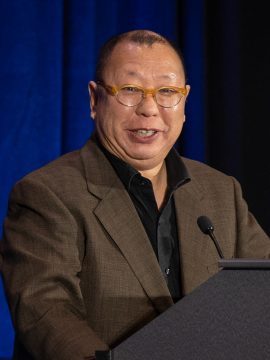
However, some ideas were a little less appealing initially, but eventually found their way into the game after being massaged a bit. Koji Kondo himself suggested the idea of a Wonder Effect that caused a real-life Mario actor to appear on-screen, humming the game’s music and doing the sound effects with his mouth. While Mouri and Tezuka were skeptical, they also felt there was something to retool and salvage from the idea, especially because they were operating under the Japanese concept of mottainai. That’s when you aren’t able to make the most of something and feel regret about it. Not wanting to waste what potential the idea had, they reworked it into what eventually became the Sound Off badge — and had Kondo himself do all of the voice work.
In fact, mottainai was the concept driving the idea behind the entire Wonder Badge system. Tezuka and Mouri wanted players to replay courses using different badges, and didn’t like the idea of players either clearing courses once and never returning to them or never swapping out their badges (which is why players can swap badges if they die). Tezuka discussed how mysteries and secrets have become a staple of Mario games, but how one of the challenges in working on Wonder was in bringing new elements to the table. When Mouri suggested an item that would transport the player to another area, Tezuka, concerned this was too similar to things done in previous Mario games, suggested the item change the environment instead. The [Wonder] seed for a new idea was officially planted.
Tezuka and Mouri also wanted to free players from the constraints of previous Mario titles, like being unable to use any power-up they wanted on a stage or to skip stages they disliked or were too difficult. Early examples of this can be seen in games like Super Mario Bros. 3, where players can store power-ups in a bank they can access from the map and activate said power-up before starting the stage. They can also do some stages out of order thanks to the board game-inspired layout of the map. In Wonder, the team took that further by creating the open map that players can traverse freely, enabling them to skip stages they’re not interested in playing. The Wonder Badges also allow players to customize their abilities and encourage replayability by retrying a course with a different badge equipped.
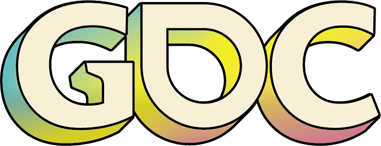
Nintendo has been notoriously hesitant to introduce true online play into the majority of its games, due in large part to their concerns about safety and differing player abilities. Iwata shared these concerns as well. They weren’t sure how to handle inexperienced players slowing down more experienced ones or quitting if they lose continuously, nor the “poor etiquette” of jerks online. Features they introduced into Wonder’s online play were meant to address these concerns. Namely, the fact that players can only help one another, like through the Standee system. Even the talking flowers exist solely to be the player’s hype men. Tezuka’s goal in creating them was to increase praise for the player, to make play more rewarding and increase their motivation. In short, driving positivity was a huge factor in creating many of the core features of Wonder.
Speaking more broadly about the future of 2D games, Tezuka is very passionate about them and held his session in the hope that it would inspire greater interest in developers working on 2D games. While he feels there’s a place for both 3D and 2D Mario games (and worries that players might think 3D Mario games have replaced the 2D games if they go too long without releasing one), he personally enjoys developing 2D games more. He said it’s easier to adjust courses and introduce new elements throughout the development of a 2D game compared to a 3D one, and that 2D game development makes it easier to focus on creating great gameplay. Mouri mentioned that Mario’s 40th anniversary is coming up next year and that he sees the Mario franchise continuing to evolve in the future.
It was amazing being able to sit feet from the developers of some of Nintendo’s biggest titles — and to be in the same room as Tezuka — hearing them discuss their challenges, motivations, and successes. As tight-lipped as the company is known for being, it’s been nice seeing them open up to the public in recent years and let the developers discuss their processes with the public. If you get the opportunity to attend GDC in the future and Nintendo is hosting a session, I’d highly suggest attending (and getting in line very early for a better chance of getting a seat!).




 ShareThis
ShareThis